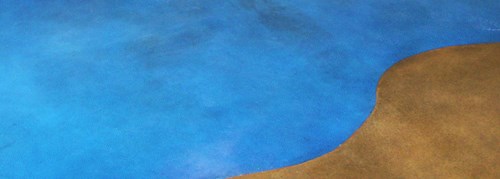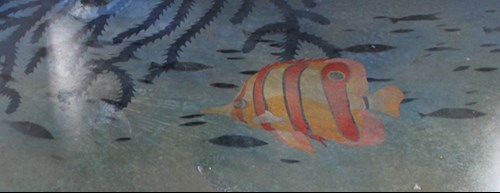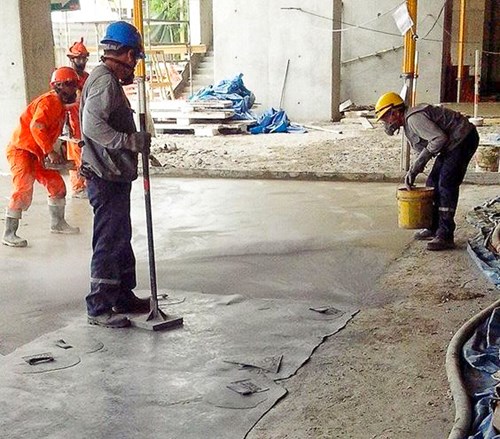The process of coloring concrete has been around for close to 100 years, but that doesn’t mean it’s old fashioned. Continuing advances in stain and color chemistry have multiplied the options and methods of coloring as well as the resulting look one can achieve. As the most widely used building material in the world, plain concrete is seldom described as beautiful. Now we have coloring methods that allow the concrete to really POP, or allow the concrete to blend into its surroundings. Perhaps you want the concrete to mimic natural stone, or to help create a theme. The large variety of coloring options allows you to do just that. Whether you are looking to color new or old concrete, horizontal slabs or vertical walls, you have many looks to choose from.
STAINS

ACID STAINS, also known as reactive stains have been around for years. Frank Lloyd Wright was using acid stains as far back as the early 1900’s. These stains don’t use pigments but rather use metallic salts to stain the concrete, bringing a unique marbling or variegated look to the slab. Different raw materials used in concrete and different finishing methods mean that every slab stained will have a slightly different appearance, almost a natural stone look. Not only do these colors become a permanent part of the surface, but various sealer and coating options can reduce maintenance and extend the life before re-staining is necessary.
WATER-BASED STAINS have grown in popularity with the green movement and the increasing concern we have about our environment. These colorants can be found in solid colors or in semi-transparent colors that mimic the look of acid stains, without the hazardous acid content. Water-based stains are made in a large spectrum of colors, shades, and tints.
STAIN SEALERS are just what the name implies; they both color and seal the concrete with one product. The acrylics used are the same acrylics found in many clear sealers, but with pigments and other ingredients added to provide a solid color to the concrete surface. Available in a wide selection of standard colors, this product can also be custom-colored to match almost any color imaginable. Formulations exist for both solvent-based and water-based versions.
The most frequently asked questions when it comes to concrete stains are: “Will the color fade over time?” and “How often will I need to re-stain my concrete?” As far as fading, the answer that covers most stains is NO, they do not fade. There may be exceptions for unusual custom colors so it is always best to check with the manufacturer, but for standard colors offered in the variety of stains we’ve mentioned, they do not fade. When it comes to re-staining there are many factors to consider so there isn’t an easy answer. Traffic (and type of traffic), weather conditions, abuse, and more all play a part in the longevity of the project. So too does the type of sealer used and what maintenance, if any, is performed.
DYES

Dyes are similar to stains in that they are a topical method of coloring concrete. However, in addition to the earth tones you find in other stains, dyes also provide more vibrant colors than the other products. Another difference is their UV stability.  Concrete dyes use pigments that are not UV safe and will fade when exposed to sunlight. Therefore, they are strictly used for interior projects only. Available in both water-based and solvent-based versions, they are most frequently used in the polishing process, although they can be sealed or coated like a stain. The color options are limitless as multiple colors can be combined and mixed to create an endless array of shades.
Concrete dyes use pigments that are not UV safe and will fade when exposed to sunlight. Therefore, they are strictly used for interior projects only. Available in both water-based and solvent-based versions, they are most frequently used in the polishing process, although they can be sealed or coated like a stain. The color options are limitless as multiple colors can be combined and mixed to create an endless array of shades.
INTEGRAL COLORS

Integral pigments used in concrete are typically synthetic iron oxides that are mixed directly into concrete before it is placed. While the basic chemistry hasn’t changed in well over 100 years, the technology behind the manufacturing and delivery process has dramatically improved. Ready mix producers are adopting automated color batching equipment as a part of their plant operations and this provides the end user with more consistent color from truck to truck – leading to a more uniform color consistency across the entire job. This coloring method saves both time and labor over staining because the color is already in the concrete when it is placed and finished. Another advantage is that the color is throughout the slab so as the surface wears you will continue to see the color – no re-staining necessary. Integral iron oxide pigments should conform to ASTM C-979 and are available in the following forms: liquid, granular, and powder. The color possibilities come from 7 primary colors: red 110, red 130, yellow, black, blue, green, and white.
 COLOR HARDENERS
COLOR HARDENERS
The other coloring method for freshly poured concrete is a color hardener that is broadcast over the surface after the concrete has been placed. Color hardener is often used as the base color for stamped concrete and it also provides durability and abrasion resistance to the concrete – hence the “hardener”. Color hardeners tend to appear more vibrant than integral colors and the finish is more dense and smooth across the top.
|
|
Indoor/Outdoor |
UV Stability |
New/Old Concrete* |
Euclid Chemical Product |
|
ACID-BASED STAINS |
Indoor/Outdoor |
Stable |
New & Old |
|
| WATER-BASED STAINS |
Indoor/Outdoor |
Stable |
New & Old |
|
|
FILM-FORMING STAINS (stain sealers) |
Indoor/Outdoor |
Stable |
New & Old |
|
|
ACETONE-SOLUBLE DYE |
Indoor |
Not Stable |
New & Old |
|
|
WATER-SOLUBLE DYE |
Indoor |
Not Stable |
New & Old |
|
|
INTEGRAL COLOR |
Indoor/Outdoor |
Stable |
New |
|
|
COLOR HARDENER |
Indoor/Outdoor |
Stable |
New |
*On new concrete a minimum cure time is required. Check product TDS for details
Alternative ways to add color to an old slab
CEMENTITOUS MICRO TOPPINGS:
For restoring old, worn, stamped concrete or to change the color, mask repairs, or renovate any slab concrete surface. RENOVATE is an easy to use two part polymermodified cementitious micro-topping that is easily applied using only a paint roller or a pump-up hand sprayer. RENOVATE can be integrally colored with THIN-CRETE COLOR PACKS or it can be stained with a variety of stains. For stamped concrete, this ultra thin coating retains the original texture and pattern, and a secondary highlight colorant ANTIQUING AGENT may be used. This tough, durable wear-bearing surface is stain resistant and easy to clean.
Concrete surfaces are designed and constructed to last for decades. However, instances occur where the surface or top layer of cement paste deteriorates due to improper placement and finishing techniques, chemical attack, or a combination of factors that take place over the course of years. While the bulk of the concrete is structurally sound, the visible portion becomes aesthetically unpleasing. Tear-out and full replacement can be quite expensive. EUCO RE-COVER has arrived as an affordable solution to expensive replacement and it can be integrally colored to provide a new look.
 ABOUT RICH COFOID
ABOUT RICH COFOID
Rich Cofoid is the Senior Marketing & Product Line Manager for Euclid Chemical's Increte decorative products. Rich travels the country and holds training classes for contractors through our national network of distributors. His training sessions include many years at World of Concrete, the Concrete Décor Show, ASCC, ACI, and AIA.